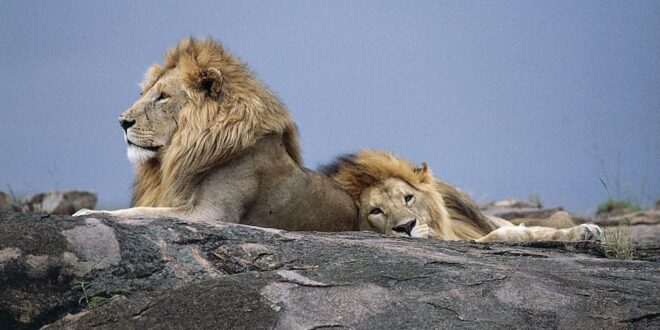The Death of a Lion: A Tragic Tale of Vulnerability and Resilience
Kenya’s breathtaking savannas are known for their majestic wildlife, and lion sightings are a common occurrence. However, on July 24, 2023, the world was stunned by the news of the demise of Jesse, one of the most tracked male lions in Kenya’s famous Maasai Mara. His death, resulting from a fierce fight with three male lions from a rival pride, shed light on the harsh realities of male lion life – a life fraught with risk and danger.
In popular belief, male lions are often seen as the kings of the jungle, epitomizing bravery, strength, and sheer size. They are second in size only to tigers. However, the truth is far different. Male lions face tremendous vulnerability from the moment they are born. From snakebites to hungry hyenas, and even infanticide at the paws of other male lions, their survival in the first year of life is only a coin toss. If they manage to make it to independence around the age of three, they embark on a dangerous period of nomadism. Out on their own, very few will see their tenth year of life.
A young male lion rests on a tree branch in Uganda’s Ishasha sector. Born as part of a three-male coalition of lions, this cub’s life is far from secure. It seems that at no point in a male lion’s life is safety guaranteed. The Kenya Wildlife Trust, resident guides, and tourists have documented Jesse’s numerous encounters and altercations with other male lions. His life, which spanned an impressive 12 years, was ultimately cut short by three younger and stronger lions. This cycle of life and death is a common occurrence, as older lions often fall victim to their younger and more aggressive peers or lions in larger, more powerful coalitions.
Research and the Trials of Male Lions
As researchers with over 50 years of combined experience in big cat ecology, conservation, and the complexities of wildlife-human coexistence, we base our observations on the extensive information gathered by various conservation organizations, independent scientists, and tourism guides working in the Maasai Mara. Sightings data and collected information on Jesse provide insights into the challenges faced by male lions.
Male lion survival is often determined by the size and strength of their coalitions and the overall lion landscape. This information becomes crucial for conservation, especially when lions venture outside of protected areas or when male lions are hunted after leaving the safety of these protected zones.
Challenges Faced by Young Lions
For a young male lion, the most significant threat to its survival comes from other male lions who are not its father or uncle. Studies conducted in the Serengeti and Zimbabwe demonstrate that infanticide by male lions accounts for a significant portion of lion cub mortalities in their first year. Incoming males often kill the cubs of other males, driving young males away and attempting to take over prides. This brutal tactic accelerates the onset of oestrus in pride females, increasing the reproductive success of the incoming males at the expense of the previous males’ offspring. Sadly, most lions pushed out of their pride at a young age do not survive.
Surviving cubs eventually reach independence around the age of three and enter a period of nomadism. During this time, they form coalitions with their cousins, brothers, and sometimes unrelated males of similar age. The power and survival chances of these coalitions increase with their size. Larger coalitions can dominate multiple prides, sire more offspring, and effectively defend their territories against rival lions and their coalitions. Notable examples include the six-strong Mapogo and the five-strong Majingilane coalitions in South Africa, as well as the Lake Quintet coalition in Tanzania’s Ngorongoro Crater. Jesse, on the other hand, only had one coalition mate called Frank. Together, they managed to oust Dere and Barrikoi from the Offbeat pride in May 2014. However, after Frank vanished, Jesse started leading a predominantly nomadic lifestyle, occasionally attempting to take over the Rakero pride and even engaging in fights with his own son, Jesse 2.
The Laws of the Wild and Lion Conservation
“Mate, protect, fight” – these are the three fundamental principles by which male animals in the wild live and die. Male lions, between the ages of 5 and 9, strive to mate with as many females as possible and protect multiple prides. However, there is a delicate balance between overpowering other males and successfully defending territories and offspring. Fights among male lions often erupt over territorial and breeding rights, sometimes resulting in conflicts within coalitions or between rival coalitions. These battles involve a range of physical and olfactory engagements, such as posturing, roaring, swatting, biting, territorial marking, and even urination.
When it comes to the conservation of lion species, it is crucial to focus on lionesses. They act as sentinels for population health, specifically monitoring the ratio of females to males. Healthy lion populations typically exhibit a ratio of roughly 2 females for every male. However, with increased poaching, human-wildlife conflicts, and declining prey availability, these ratios skew in favor of males. Understanding the dynamics of individual lions, such as Jesse, not only helps raise public awareness and foster appreciation for the species but also underscores the critical need to protect lions and their habitats.
Kenya boasts a substantial lion population and several iconic wildlife areas, contributing significantly to the nation’s pride. Despite the high human pressures on these majestic creatures, the captivating stories of lion prides and the trials faced by individual lions continue to captivate the public’s imagination. By safeguarding these assets, we can ensure the survival and prosperity of Kenya’s lions and inspire conservation efforts for the benefit of future generations.
 Mind Uncharted Explore. Discover. Learn.
Mind Uncharted Explore. Discover. Learn.




